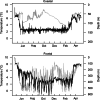Hidden but revealed: After years of genetic studies behavioural monitoring combined with genomics uncover new insight into the population dynamics of Atlantic cod in Icelandic waters
- PMID: 36793686
- PMCID: PMC9923494
- DOI: 10.1111/eva.13471
Hidden but revealed: After years of genetic studies behavioural monitoring combined with genomics uncover new insight into the population dynamics of Atlantic cod in Icelandic waters
Abstract
Stock structure is of paramount importance for sustainable management of exploited resources. In that context, genetic markers have been used for more than two decades to resolve spatial structure of marine exploited resources and to fully fathom stock dynamics and interactions. While genetic markers such as allozymes and RFLP dominated the debate in the early era of genetics, technology advances have provided scientists with new tools every decade to better assess stock discrimination and interactions (i.e. gene flow). Here, we provide a review of genetic studies performed to understand stock structure of Atlantic cod in Icelandic waters, from the early allozyme approaches to the genomic work currently carried out. We further highlight the importance of the generation of a chromosome-anchored genome assembly together with whole-genome population data, which drastically changed our perception of the possible management units to consider. After nearly 60 years of genetic investigation of Atlantic cod structure in Icelandic waters, genetic (and later genomic) data combined with behavioural monitoring using Data Storage Tags shifted the attention from geographical population structures to behavioural ecotypes. This review also demonstrates the need for future research to further disentangle the impact of these ecotypes (and gene flow among them) on the population structure of Atlantic cod in Icelandic waters. It also highlights the importance of whole-genome data to unravel unexpected within-species diversity related to chromosomal inversions and associated supergenes, which are important to consider for future development of sustainable management programmes of the species within the North Atlantic.
Keywords: Gadus morhua; Iceland; behavioural ecotypes; genetics/genomics; management perspective; stock structure.
© 2022 The Authors. Evolutionary Applications published by John Wiley & Sons Ltd.
Conflict of interest statement
The authors declare no competing interests.
Figures




References
-
- Akopyan, M. , Tigano, A. , Jacobs, A. , Wilder, A. P. , Baumann, H. , & Therkildsen, N. O. (2022). Comparative linkage mapping uncovers recombination suppression across massive chromosomal inversions associated with local adaptation in Atlantic silversides. Molecular Ecology, 31, 3323–3341. 10.1111/mec.16472 - DOI - PubMed
-
- Andersen, Ø. , Wetten, O. F. , De Rosa, M. C. , Andre, C. , Alinovi, C. C. , Colafranceschi, M. , Brix, O. , & Colosimo, A. (2009). Haemoglobin polymorphisms affect the oxygen binding properties in Atlantic cod populations. Proceedings of the Royal Society B: Biological Sciences, 276, 833–841. - PMC - PubMed
-
- Árnason, E. , Pálsson, S. , & Arason, A. (1992). Gene flow and lack of population differentiation in Atlantic cod, Gadus morhua L., from Iceland, and comparison of cod from Norway and Newfoundland. Journal of Fish Biology, 40, 751–770.
-
- Árnason, E. , Petersen, P. H. , Kristinsson, K. , Sigurgíslason, H. , & Pálsson, S. (2000). Mitochondria cytochrome b DNA sequence variation of Atlantic cod from Iceland and Greenland. Journal of Fish Biology, 56, 409–430.
Publication types
LinkOut - more resources
Full Text Sources

